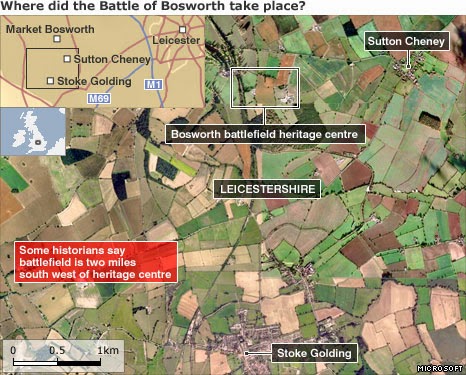Wednesday, March 18, 2015
New battle over Bosworth's site
It is more than 500 years since the Battle of Bosworth saw the death of Richard III and ushered in the Tudor dynasty.
Since then scholars have argued over the precise location of the battle with several different locations given serious consideration.
Now a team of historians and archaeologists says it has found the site - and it is not where everyone thought it was.
It is one of Shakespeare's most memorable scenes.
The hunchback Richard III, thrown from his horse and maddened with blood lust, offers up his kingdom in exchange for a replacement steed.
Today the spot where he is supposed to have met his end - a victim of treachery rather than military genius - is marked by a roughly-cut stone memorial in a quiet grove.
The plaque upon it reads simply: "Richard, the last Plantagenet King of England, was slain here 22nd August, 1485."
Except that he was not.
According to a team of battlefield experts and historians the location of the battlefield was two miles to the south and west. At the moment they are being no more precise than that because they fear the activities of illegal treasure seekers.
The investigators have been checking soil samples, analysing peat deposits and carrying out searches with metal detectors. They have also been studying ancient documents and maps for clues.
Using references to places like Redmore (or Reed Moor) and Sandyford (a sandy crossing in the marsh) they have built up a picture of the landscape at the time of the battle.
There have been other clues such as Crown Hill, long thought to have had some connection with the crowning of Henry VII after the battle.
And the study has thrown new light on the use of medieval artillery. They have found 22 lead shots fired by the smallest hand-held gun of the time and from the largest cannon of the time.
All of which presents a problem for the Bosworth Battlefield Heritage Centre which has become popular with tourists, schoolchildren and students. Thousands have attended lectures on the subject and walked for two hours over the battlefield trail.
When the location has been debated before, visitors have expressed mixed feelings.
Many said the precise location of the centre was less important than the quality of educational displays and exhibitions. Others said they would be disappointed not to be able to walk the actual field of battle.
Dr Glen Foard, from the Battlefields Trust, who has led the search, said: "For me the most important thing about the discoveries at Bosworth is that it opens the door for archaeology to explore the origins of firepower.
"In collaboration with the University of Leeds we want to trace this story across Europe."
Subscribe to:
Post Comments (Atom)

No comments:
Post a Comment